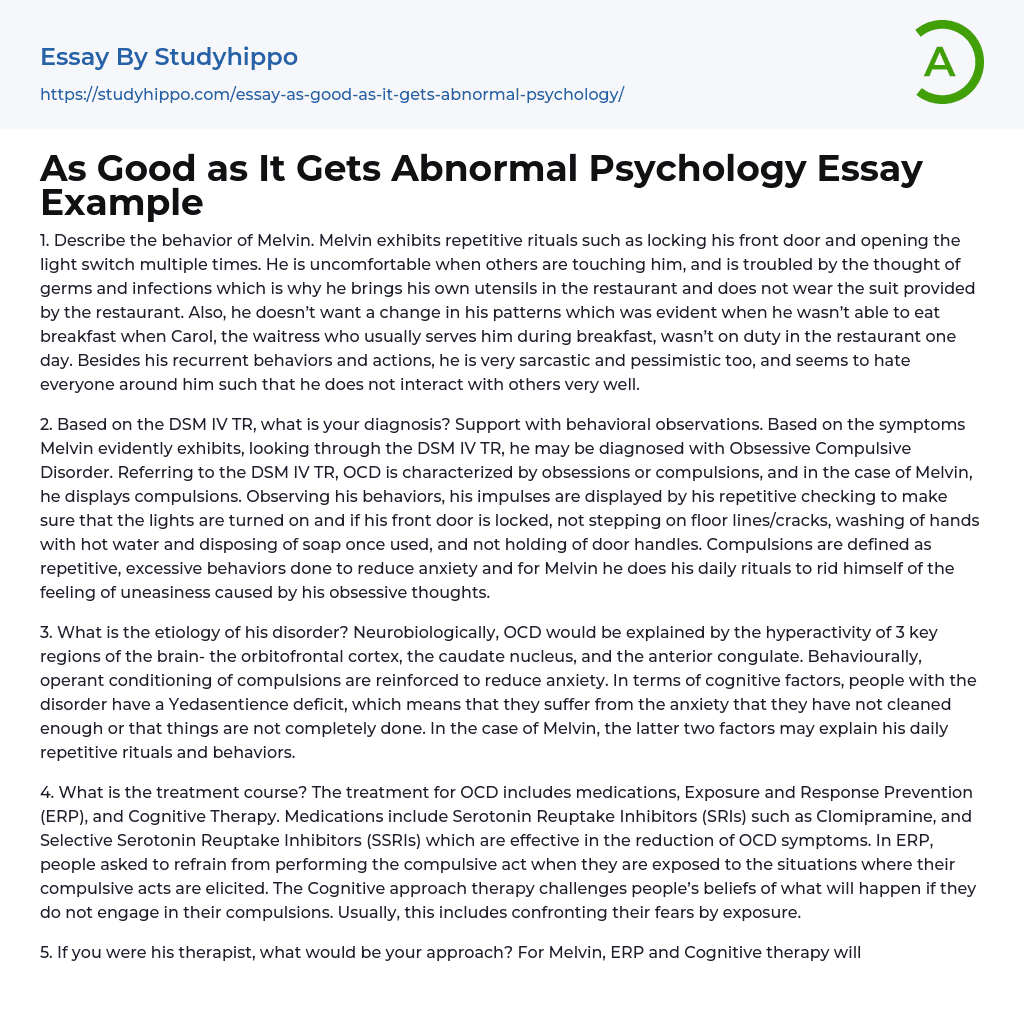1. Describe the behavior of Melvin. Melvin exhibits repetitive rituals such as locking his front door and opening the light switch multiple times. He is uncomfortable when others are touching him, and is troubled by the thought of germs and infections which is why he brings his own utensils in the restaurant and does not wear the suit provided by the restaurant. Also, he doesn’t want a change in his patterns which was evident when he wasn’t able to eat breakfast when Carol, the waitress who usually serves him during breakfast, wasn’t on duty in the restaurant one day. Besides his recurrent behaviors and actions, he is very sarcastic and pessimistic too, and seems to hate everyone around him such that he does not interact with others very well.
2. Based on the DSM IV TR, what
...is your diagnosis? Support with behavioral observations. Based on the symptoms Melvin evidently exhibits, looking through the DSM IV TR, he may be diagnosed with Obsessive Compulsive Disorder. Referring to the DSM IV TR, OCD is characterized by obsessions or compulsions, and in the case of Melvin, he displays compulsions. Observing his behaviors, his impulses are displayed by his repetitive checking to make sure that the lights are turned on and if his front door is locked, not stepping on floor lines/cracks, washing of hands with hot water and disposing of soap once used, and not holding of door handles. Compulsions are defined as repetitive, excessive behaviors done to reduce anxiety and for Melvin he does his daily rituals to rid himself of the feeling of uneasiness caused by his obsessive thoughts.
3. What
is the etiology of his disorder? Neurobiologically, OCD would be explained by the hyperactivity of 3 key regions of the brain- the orbitofrontal cortex, the caudate nucleus, and the anterior congulate. Behaviourally, operant conditioning of compulsions are reinforced to reduce anxiety. In terms of cognitive factors, people with the disorder have a Yedasentience deficit, which means that they suffer from the anxiety that they have not cleaned enough or that things are not completely done. In the case of Melvin, the latter two factors may explain his daily repetitive rituals and behaviors.
4. What is the treatment course? The treatment for OCD includes medications, Exposure and Response Prevention (ERP), and Cognitive Therapy. Medications include Serotonin Reuptake Inhibitors (SRIs) such as Clomipramine, and Selective Serotonin Reuptake Inhibitors (SSRIs) which are effective in the reduction of OCD symptoms. In ERP, people asked to refrain from performing the compulsive act when they are exposed to the situations where their compulsive acts are elicited. The Cognitive approach therapy challenges people’s beliefs of what will happen if they do not engage in their compulsions. Usually, this includes confronting their fears by exposure.
5. If you were his therapist, what would be your approach? For Melvin, ERP and Cognitive therapy will most likely be the best approach for treating his OCD. The ERP is for him to refrain from performing his rituals for the eventual extinction of his compulsive acts due to his anxiety. The Cognitive approach will be for him to be exposed to his fear of contamination, germs and dirty objects to challenge his fears and beliefs regarding this concern.
- Anatomy and Physiology essays
- Addiction essays
- Biodegradation essays
- Dental Care essays
- Disease essays
- Disorders essays
- Health Care essays
- Intelligence Quotient essays
- Nutrition essays
- Olfaction essays
- Public Health essays
- Women's Health essays
- World health organization essays
- Cancer essays
- Infectious Disease essays
- Lung Cancer essays
- Neurology essays
- Physical Exercise essays
- Medicine essays
- Sex essays
- Inquiry essays
- Disability essays
- Poison essays
- Action Potential essays
- Nervous System essays
- Childbirth essays
- Puberty essays
- Blood essays
- Kidney essays
- Neuron essays
- Body essays
- Glucose essays
- Sense essays
- Heart essays
- Skeleton essays
- Human Physiology essays
- Eye essays
- Immune System essays
- Muscle essays
- Skin essays
- Brain essays
- Central Nervous System essays
- Human Skin Color essays
- Digestive System essays
- Common sense essays
- Respiration essays
- alcoholism essays
- Smoking essays
- Casino essays
- Tobacco essays




